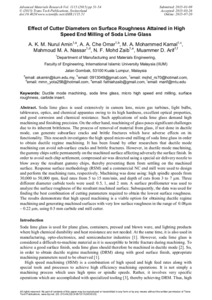Amin, A. K. M. Nurul and Omar, A.A. Che and Kamal, M.A.Mohammed and Nassar, Mahmoud M.A. and Zaib, N.F. Mohd and Arif, Muammer Din (2015) Effect of cutter diameters on surface roughness attained in high speed end milling of soda lime glass. Advanced Materials Research, 1115. pp. 51-54. ISSN 1662-8985
![[img]](http://irep.iium.edu.my/46257/1.hassmallThumbnailVersion/First_page_Effect_of_Cutter_Dia_on_Surf_Rough_in_Soda_Lime_HSM.gif)
|
PDF (Effect of Cutter Diameters on Surface Roughness Attained in High Speed End Milling of Soda Lime Glass)
- Published Version
Download (79kB) | Preview |
|
|
PDF (Full Paper_ Effect of Cutter Diameter on Surface Roughness Attained in High Speed End Milling of Soda Lime Glass)
- Published Version
Restricted to Registered users only Download (470kB) | Request a copy |
Abstract
Soda lime glass is used extensively in camera lens, micro gas turbines, light bulbs, tablewares, optics, and chemical apparatus owing to its high hardness, excellent optical properties, and good corrosion and chemical resistance. Such applications of soda lime glass demand high machining and finishing precision. On the other hand, machining of glass poses significant challenges due to its inherent brittleness. The process of removal of material from glass, if not done in ductile mode, can generate subsurface cracks and brittle fractures which have adverse effects on its functionality. This research investigates the high speed micro-end milling of soda lime glass in order to obtain ductile regime machining. It has been found by other researchers that ductile mode machining can avoid sub-surface cracks and brittle fractures. However, in ductile mode machining, the gummy chips settle permanently on the machined surface affecting adversely the surface finish. In order to avoid such chip settlement, compressed air was directed using a special air delivery nozzle to blow away the resultant gummy chips, thereby preventing them from settling on the machined surface. Response surface methodology (RSM) and a commercial NC end mill were used to design and perform the machining runs, respectively. Machining was done using: high spindle speeds from 30,000 to 50,000 rpm, feed rates from 5 to 15 mm/min, and depth of cuts from 3 to 7 μm. Three different diameter carbide tools were used: 0.5, 1, and 2 mm. A surface profilometer was used to analyze the surface roughness of the resultant machined surface. Subsequently, the data was used for finding the best combination of cutting parameters required to obtain the lowest surface roughness. The results demonstrate that high speed machining is a viable option for obtaining ductile regime machining and generating machined surfaces with very low surface roughness in the range of 0.08μm – 0.22 μm, using 0.5 mm carbide end mill cutter.
| Item Type: | Article (Journal) |
|---|---|
| Additional Information: | 2872/46257 |
| Uncontrolled Keywords: | Ductile mode machining, soda lime glass, micro high speed end milling, surface roughness, carbide insert. |
| Subjects: | T Technology > TJ Mechanical engineering and machinery |
| Kulliyyahs/Centres/Divisions/Institutes (Can select more than one option. Press CONTROL button): | Kulliyyah of Engineering > Department of Manufacturing and Materials Engineering |
| Depositing User: | Dr. A.K.M. Nurul Amin |
| Date Deposited: | 29 Dec 2015 11:34 |
| Last Modified: | 29 Dec 2015 11:34 |
| URI: | http://irep.iium.edu.my/id/eprint/46257 |
Actions (login required)
 |
View Item |


 Download Statistics
Download Statistics Download Statistics
Download Statistics